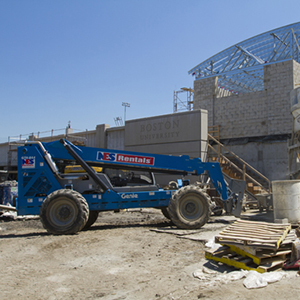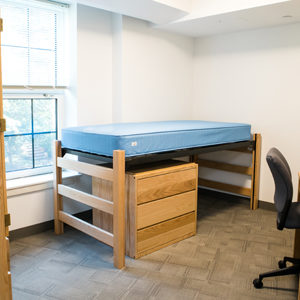What summer vacation? Construction crews on the Charles River Campus have spent the last three months feverishly working to complete or make headway on more than 20 projects, ranging from a new athletic field to campus apartment renovations, at a cost of about $60 million.
Summer is prime time to work on large-scale construction projects, which are often loud and complicated, and involve many moving parts, says David Flynn, assistant vice president of construction services at Facilities Management & Planning. “Both the campus and the city are abuzz with activities, but the population gets smaller,” Flynn says. “It’s our opportunity to do work, as getting materials and people to the job sites is easier.”
For Colleen McGinty, executive director of construction services, that meant many days this summer started as early as 7 a.m., when she and her team would assemble to consult with all of the engineers, architects, builders, and individual clients involved in the projects. “My whole team worked around the clock,” says McGinty, who’s been with the University for 27 years.
While about $60 million worth of work has already been completed, there will be an additional $20 to 30 million spent this fall on ongoing projects, according to Gregg Snyder, assistant director for financial analysis and budgeting at Facilities Management & Planning.
While you were gone: the rundown
Starting in Kenmore Square, this summer’s construction projects included renovations to Myles Standish Hall. The 660 students who moved in last month likely noticed that 80 bathrooms had been freshly painted and outfitted with new storage cabinets, flooring, sinks, and more efficient faucets and flushometers, and that the bathtubs had been resurfaced. A new first-floor student space was created, open to all BU students 24 hours a day.
The first floor of Kilachand Hall, the former Shelton Hall, underwent a gut renovation to make space for Kilachand Honors College students and some from other schools and colleges. Phase one of the project consisted of the addition of office space, as well as upgrades to the restrooms, common space, laundry area, and bike rooms. The old dining room off the main lobby was converted into a student lounge and study area. The new spaces feature cork floors and LED lighting, and the renovation places a heavy emphasis on sustainability. Phase two of the project is scheduled for next summer.
School of Management renovations included the addition of 7 new offices, 10 breakout rooms, 2 flat-floor classrooms with 40 seats, as well as tiered case rooms and classrooms. The Frederick S. Pardee Management Library was renovated to improve services and study spaces. The consolidation of the library onto the second and third floors also created space for new library staff offices, and the third-floor library space got new furniture and finishes. The reference area was redesigned to provide more individual consulting areas for librarians to meet with students. New classrooms were added on SMG’s fourth floor to create more space for the Executive MBA program, and the Executive Leadership Center was consolidated to the west end of the fourth floor. Public corridors on the fourth floor also received new finishes.
The College of Engineering department of biomedical engineering underwent renovations to its second-floor lab at 24 Cummington Mall, while 38 Cummington Mall was renovated for use by biomedical engineering grad students.
At Sargent College’s physical therapy lab, in the basement of 635 Commonwealth Ave., state-of-the-art media and AV equipment were installed.
The garage at Warren Towers was inspected and repaired as part of a multiyear renewal and restoration program.
One of the University’s most visible construction projects, the Leadership in Energy & Environmental Design (LEED)–certified Admissions Reception Center, is slated to open in January 2014. The building, which was the University’s former Hillel House, is undergoing both an extensive exterior and interior restoration, and the addition of 2,500 square feet will include a 150-seat auditorium. The center will eventually connect to the Castle next door, and both buildings will be accessible to people with disabilities. This project also includes the redesign of the George D. Hart Way, with a new landscaped pedestrian plaza to serve as a gathering space for student tour groups.
South Campus residents, rejoice. Kitchen and bath renovations were done in 16 undergraduate apartments at 3 and 5 Buswell Street. The units got new paint jobs, carpets, energy-efficient fixtures, and Energy Star appliances.
Last year, the National Institutes of Health awarded BU a $10 million, five-year grant to establish the Autism Center of Excellence (ACE). The site of the new center, 100 Cummington Mall, was selected because of its proximity to other research facilities, its access to pedestrians, and its available parking. Before renovations could begin, the building’s residents, Metropolitan College’s actuarial sciences department and Information Services & Technology, had to relocate to 808 Commonwealth Ave. and 111 Cummington Mall, respectively. Construction began in July and will be finished by October.
The College of Arts & Sciences had new energy-efficient windows installed, similar to the recent restoration of windows at Metropolitan College and the School of Theology. The Massachusetts Historical Commission approved renovations on CAS’ Gothic Revival windows, which were originally designed by Cram & Ferguson Architects, specialists in sacred and academic buildings. The new windows, designed by Modern Manufacturing, are energy-efficient and compatible with modern technology, but also sensitive to the original design.
In the School of Theology basement, the STH Community Center was renovated, with new multipurpose areas for studying, meetings, recreation, community meals, and art exhibitions. Some existing offices were moved to other parts of the building, and the basement restrooms were reconfigured to better serve people with disabilities. The renovation was a LEED-registered project.
Another highly visible project, the School of Law expansion and renovation, continued this summer. The work focused on construction of the new west wing, which will house many of LAW’s classrooms and additional library and study space. Completion of the wing is slated for June 2014. Upgrades to the existing 265-foot tower will include refurbishments to exterior concrete panels and installation of thermally insulated windows and new mechanical, electrical, and plumbing systems. The work is expected to be completed by August 2015. A groundwater recharge system was installed this summer. The LEED-registered project is made possible by an $18 million gift from Sumner M. Redstone (Hon.’94).
Work began this summer on the new 20,000-square-foot Engineering Product Innovation Center (EPIC), a teaching and design studio equipped with the latest industry technology. When it opens in January 2014, it will house a computer-aided design studio, demonstration areas, fabrication facilities, materials testing, and project management software. The facility will also offer College of Engineering students supply chain management software, 3-D printers, robotics, and laser processing. EPIC will occupy the space that once housed the former Guitar Center as well as a small portion of the existing parking lot next door. The remainder of the parking lot will house faculty research labs and offices.
The Charles River Campus’ Human Resources department, 25 Buick Street, will have new digs when its space is ready in January. The second-floor office space is undergoing a gut renovation, with new finishes, furniture, and HVAC, and upgraded electrical work.
The living room and dining room furniture in StuVi I’s 233 apartments was reupholstered or replaced this summer.
Up the street at FitRec, the competition pool was emptied, the interior examined, and the grout replaced. Workers repaired the sparger aeration system, which is at the bottom of the pool directly under the diving platform. The system provides a mound of highly aerated water to cushion the impact for divers.
This summer saw the completion of New Balance Field in West Campus. The AstroTurf field is configured for field hockey, lacrosse, and soccer use, and will double BU’s athletic field capacity. The open-air field features bleacher seating, a brick facade, and parking. (A bit of work is still being done on the landscaping.) While not eligible for LEED certification, construction closely followed LEED guidelines. The field will be formally dedicated September 19.
Finally, fire alarms were upgraded at 15 residential buildings across campus, with new control panels, emergency lights, and exit signs.
With many of the summer projects now completed, McGinty is ready to hand the keys over to the custodians and area managers, who are the “first line of responders” to report equipment that isn’t working correctly. “We spend a lot of time meeting with tradespeople to show them the work we have done, like some sophisticated mechanical systems, HVAC systems, new fire alarm systems, high-tech audio equipment, and plumbing work in the labs,” she says. “If they discover that something isn’t working as it should, we try to fix it right away.”
Flynn says that a few projects are in the planning stages for the Medical Campus: a project for the dermatology department, the development of a zebra fish facility, and a new Subway restaurant on Albany Street.
Andy Costello, David Keefe, and Kristina Roman contributed to the multimedia for this story.


































































This is great, but the leaking roof in Mugar Library desperately needs attention.